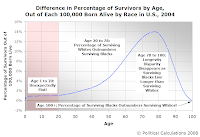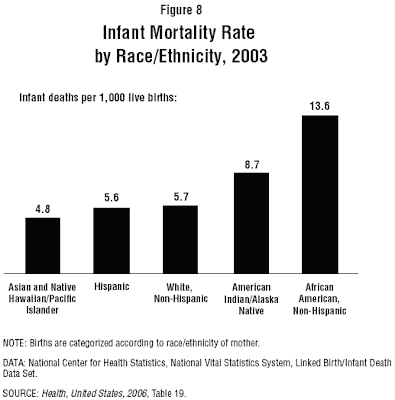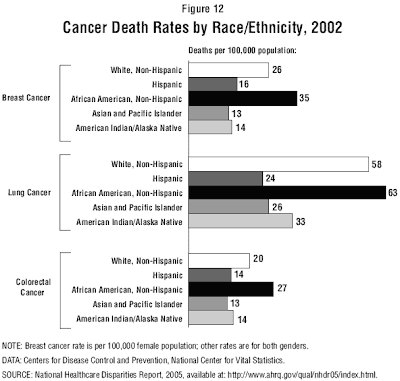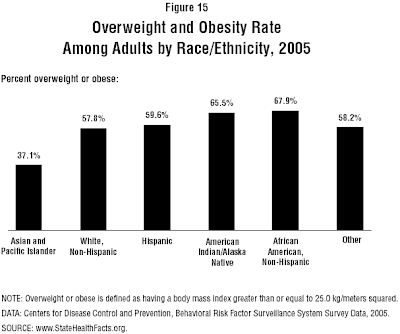
Most of the graphs we'll present have been extracted from the Kaiser Family Foundation's January 2007 report Key Facts: Race, Ethnicity & Medical Care, specifically from Section 2 of the report which covers the comparative health status of different racial and ethnic populations in the U.S. Beyond that, we've also extracted some data from the U.S. Centers for Disease Control for the comparative mortality rates attributable to cerebrovascular disease (stroke, hypertension) and infectious diseases.
Infant Mortality
As we showed previously, an 0.8% gap between the number of surviving members out of every 100,000 born opens up between the black and white populations of the U.S. in the first year of life. The chart below shows that as of 2003, the black, non-Hispanic population of the U.S. hand more than double the infant mortality rate of the Asian, Hispanic, and white populations, and was a third greater than the American Indian/Alaska Native population:

Greater detail on the causes of infant mortality between the black and white population is available in the April 2008 Journal of Perinatology article, Ethnic differences in infant mortality by cause of death. In particular, premature birth/low birth weight stands out as the condition most associated with black infant mortality, with an unexpected indication that black mothers in their twenties and early thirties are much more likely than teenage mothers to give birth to babies with this condition.
Heart Disease
Heart disease is the leading causes of death for all people in the United States, so it's not unexpected that it's also a leading killer of non-Hispanic African Americans.

As we can see in the chart above, non-Hispanic blacks have more than double the rate of deaths from heart disease as Asians/Pacific Islanders, just about double the death rate observed for the American Indian/Alaskan Native population, and a bit under double the death rate for Hispanics. Compared to the white population, blacks have approximately a quarter more death per 100,000 population. We also observe that these relative ratios hold across men and women, even though women have substantially lower death rates due to heart disease.
Cancer
To put it as the Kaiser Family Foundation did "African Americans have a higher death rate from breast, lung, and colorectal cancer than any other racial or ethnic group."

In the chart above, we see that the black population is far more likely than all other racial/ethnic groups to have either breast cancer or colorectal cancer. Meanwhile, we see a much lesser difference between the white and black populations for lung cancer as compared to other groups. For lung cancer, we would attribute the minor difference between whites and blacks as being due to blacks having a slightly higher rate of tobacco consumption than whites, while the major differences observed with all other racial/ethic groups is due to the much lower rates of tobacco consumption by these groups compared to both blacks and whites.
Cerebrovascular Disease
Cerebrovascular disease (CVD) is the catch-all term that covers a host of blood vessel-related diseases and conditions, such as hypertension (high blood pressure) and atherosclerosis (hardening of arteries), which is a leading cause of strokes.

We see in the chart above that the black population is especially susceptible to death resulting from cerebrovascular conditions, having more than double the death rate of all other ethnic and racial groups through Age 74.
Infectious Diseases
We're only going to show HIV disease as a proxy for all types of infectious disease, although the greatly disproportionate racial disparities apply to other infectious diseases:

The difference between the death rates for blacks and other racial/ethnic groups due to HIV disease (AIDS) is absolutely stunning, with the black population being anywhere from 3 to 30 times more likely to die as a result of HIV than the other racial and ethnic groups.
We'll also note that the U.S. black population has much higher death rates than other racial/ethnic groups for other infectious diseases, such as tuberculosis, septicemia and infections of the kidneys and urinary tract. Altogether, this 2001 study by Jan H. Richardus and Anton E. Kunst into Black-White Differences in Infectious Disease Mortality in the United States found that "infectious diseases account for nearly 10% of the excess all-cause mortality rates in Blacks compared with Whites". That discrepancy exists even after accounting for socio-economic factors.
Contributing Conditions
Not all health conditions or diseases lead to death, but some do contribute to other causes of death. Diabetes is one such condition, for which blacks are more likely to have than whites (although at similar rates as Hispanics):

Meanwhile, obesity also contributes to a number of other diseases, such as diabetes and cardiovascular problems (heart disease, cerebrovascular disease):

Here, we see that the black population has a very high rate of being overweight or obese, but doesn't stand out among other racial or ethnic groups in the United States. At least the way that Asian and Pacific Islanders do with their very low rate of obesity compared to the other groups!
That concludes our review of what we're up against. In the next part of this series, we'll compare the life expectancies of African Americans to Africans, and how what might be called African curses and blessings affect the disproportionate killers of the black population in the United States that we identified today....
All the Posts in the Series
For reference, here are all of the posts in our series covering the racial disparity between the life expectancies in the United States:
- Blacks Living Longer Than Whites
The post that started the whole thing! We were surprised to find that blacks over the age of 80 had longer remaining life expectancies than whites of the same ages in the U.S. We also used the opportunity to ridicule some pretty blatant rent-seeking behavior on the part of researchers seeking funding for their work.
- Erasing the Gap in Racial Life Expectancies
We revisited the life expectancy figures between blacks and whites and took a closer look at the underlying data, which allowed us to reject racism as an explanation for what we observed. We also began asking "why this, but not this?" in comparing not just the survivorship of the black and white populations of the United States, but urban vs rural blacks, immigrant vs native-born blacks, and the effect of older vs younger mothers for African American infant mortality.
- The Disproportionate Killers
You can't address racial disparities in life expectancies unless you know what chronic health conditions disproportionately affect the black population of the United States compared to other racial or ethic groups.
- African Blessings, African Curses
Chronic diseases often have a very strong genetic or heredity component in determining who is vulnerable to them. In this post, we explored the idea that what doesn't kill you either softens you up for what will or makes you more vulnerable to other health hazards in comparing the black population of the United States to sub-Saharan Africans who share much the same genetic anthropology, while also discovering very recent research whose results potentially explain why all peoples of African descent are more vulnerable to the things that disproportionately kill African Americans.
- A Seemingly Simple Solution
Does a chronic vitamin deficiency explain why the disparities between black and white life expectancies in the U.S.? We explore this possibility and why it may not as easy to address as you might think on first glance, as well as how individual African Americans might do so successfully.
Welcome to the blogosphere's toolchest! Here, unlike other blogs dedicated to analyzing current events, we create easy-to-use, simple tools to do the math related to them so you can get in on the action too! If you would like to learn more about these tools, or if you would like to contribute ideas to develop for this blog, please e-mail us at:
ironman at politicalcalculations
Thanks in advance!
Closing values for previous trading day.
This site is primarily powered by:
CSS Validation
RSS Site Feed
JavaScript
The tools on this site are built using JavaScript. If you would like to learn more, one of the best free resources on the web is available at W3Schools.com.